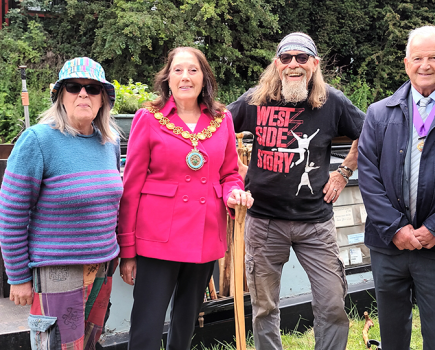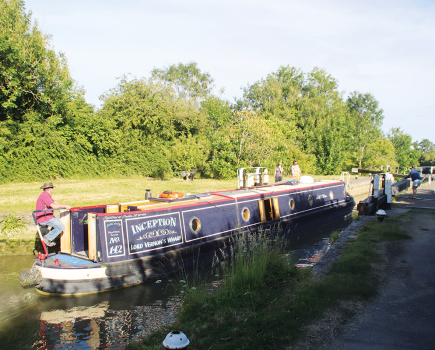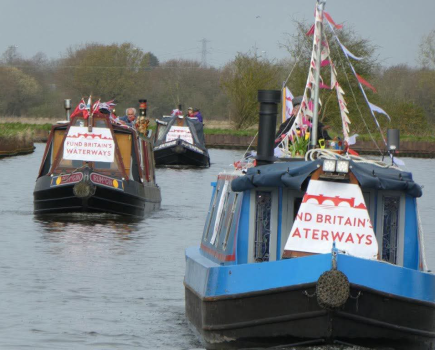The southern Grand Union forms the backbone of the canal system in the southern half of the country, was once a busy trade artery.

When it was opened, the route from Braunston to London created a short-cut for freight traffic from the Midlands to London.

Completed in 1805, this direct route knocked over 60 miles off the old route between the Midlands and London via the Oxford canal and the River Thames. It was also created as a broad canal with locks wide enough to accommodate two narrowboats.

Built as the Grand Junction Canal, it became part of the Grand Union in a merger with other adjoining canals in 1929. Despite railway competition it remained a busy commercial waterway until the early 1960s. A British Waterways publication for 1957 states that almost one million tonnes of freight was carried on the Grand Union in that year. Commodities included coal from the Midlands, plus timber, grain, iron, steel, cement and tar.

However, improved road communications and the severe winter of 1962-63 finally put the nail in the carrying coffin as far as regular long-distance freight was concerned.

A Transport Trust plaque at Braunston describes the village as ‘the hub of the English canal network’. Braunston is still a very busy boating centre just as it was in its commercial heyday, except that now it’s pleasure boating as opposed to working boats. However, on one summer weekend (29-30 June this year) old working craft gather at Braunston for an annual rally and the canal is crowded with historic vessels.

The village with its prominent church spire sits on a hill overlooking the canal. It has a store, a butcher’s, and pubs alongside the waterway below. For boaters, Braunston has a marina, boatbuilders, boatyards, chandleries and hire fleet beside the start of six locks climbing to a long tunnel.
The tunnel is wide enough for two narrowboats to pass inside, and emerges into a pleasant green cutting and then to Norton Junction. This is where the Grand Union Canal’s Leicester Section starts its journey northwards to Foxton, Leicester and beyond. The main line begins its descent from the summit at Buckby Top Lock where the New Inn (currently closed, but a reopening is rumoured) stands next to the busy A5 trunk road. Seven locks carry the canal down to Whilton Marina which stands between the canal and the main line railway.
Now follows a delightful stretch from Whilton to Weedon passing through Brockhall Spinney. Weedon has several pubs in the village and one by the canal at Stowe Hill overlooking a number of boatyards. The former Royal Ordnance Depot at Weedon once had its own canal arm, the remains of which can still be seen.
In seven miles of pleasant undulating countryside the canal passes a marina at Bugbrooke and reaches Gayton. This is the junction with the Northampton Arm which leads down a flight of locks to the River Nene and eventually to the Fenland waterways. Gayton now has a large new marina close to the junction.
Blisworth village is just a mile further on, with another boatyard, village shops, pubs and post office. Now comes Blisworth Tunnel, at 3,056 yards the third longest navigable tunnel in the country. It’s a long way in the dark, but all the delights of Stoke Bruerne lie at the other end.
Much of the scene around the top lock at Stoke Bruerne would still be recognisable to the working boatmen. Fifty years ago the old corn mill was transformed into the Canal Museum but the cottages and the pub are still there, pretty much intact with the odd extension. A second pub which reopened in the 1990s (after being closed for well over a century) on the other side of the bridge is usually busy with customers sitting outside in fine weather watching the boats pass by. Boat trips to the tunnel leave from outside the waterside cafe next to the museum.
Seven locks carry the canal away from Stoke Bruerne, into the countryside leading to Cosgrove. This is a charming village with a fine decorative sandstone bridge, a narrow pedestrian tunnel under the canal, and the junction with the defunct Buckingham Arm whose first few yards are used for mooring – but which is subject to restoration plans. The Iron Trunk Aqueduct over the River Great Ouse is about half a mile further on.
The canal now reaches Old Wolverton, once famous for its railway works, but now the watery entrance to Milton Keynes. The canal environs are mostly very pleasant in its ten mile journey around the new town. Banks are well kept as the canal steers clear of the centre – but it usually stays within reach of a pub. There is a new aqueduct over a main road at Bradwell and a marina at Peartree Bridge. Former villages like Great Linford and Woughton on the Green have managed to keep a lot of their character despite being absorbed into Milton Keynes. The area around Bridge 82 at Newlands could be the future junction for the proposed Bedford & Milton Keynes Waterway. Newlands is also the location for the Gulliver’s Land children’s theme park, and Willen Lakes are nearby.
Milton Keynes is finally left behind after Bridge 99 as the canal drifts into open countryside leading to Stoke Hammond. At Soulbury a pub overlooks the three locks. The length between Soulbury and Leighton Buzzard was called ‘The Jackdaw Pound’ by the working boatmen. It includes the renowned Globe Inn at Linslade situated on the towpath and liberally bedecked in flowers during the summer months.
After Leighton Lock we enter Leighton Buzzard, passing a popular hire fleet base. There’s a waterside supermarket so it’s a good place to stock up. Once clear of the town, eight miles of open country lead to Marsworth. Locks are well spaced out and there are wide views across the fields towards the Ivinghoe Hills, a marina and pub at Grove Lock and a boatyard at Pitstone Wharf. This is Great Train Robbery country: it took place near Cheddington 50 years ago on 8 August 1963.
Marsworth is a real gem of a canal centre situated in open country next to the huge reservoirs that feed the canal’s summit level. There are seven locks climbing to the summit, a couple of good pubs, and a tea room at Startops End near the reservoir. The Aylesbury Arm leaves below the locks, descending through 16 locks (one of them currently closed for emergency repairs) to Aylesbury Basin six miles away. Above Marsworth Locks is a second junction, where the Wendover Arm begins: presently navigable for just over a mile to a winding hole beyond Tringford, it’s under restoration back to Wendover. Bulbourne Workshops where lock gates used to be made can also be seen above the top lock, opposite a popular pub with a garden.
We are now on the two-mile long Tring Summit. In a beautiful wooded cutting, it is reputedly at a similar altitude to the top of St Paul’s Cathedral. You emerge at the delightfully named Cowroast Lock where there is a large marina. There are more locks at Dudswell and Northchurch as the canal descends into Berkhamsted.
A supermarket stands next to the towpath soon after Lock 52, and there are plenty of shops and services in the town centre, while three canalside pubs provide sustenance for the weary boater. Look for the totem pole that stands in a former timber yard and was given to the owners by a Canadian customer. The remains of Berkhamsted Castle can be seen just beyond the railway.
Locks come thick and fast now, with the consolation of a canalside pub by the swing bridge at Winkwell and another by Fishery Lock at Hemel Hempstead. Apsley has a marina and a new steel footbridge connecting housing developments which have replaced the paper mills that once used the canal.
More locks at Nash Mills are followed by a welcome gap before reaching Kings Langley. This was the home of Ovaltine which had its own fleet of boats for over 30 years and was one of the last regular commercial users of the southern Grand Union.
It gets a bit noisy with the M25 striding across the canal and the A41 trunk road alongside the locks at Hunton Bridge, but things improve after Lady Capel’s Lock as the canal nears Watford. The ornamental Grove Park Bridge is one of the finest of its type. The estate belonged to the Earl of Clarendon whose Grove Park mansion is now a luxury hotel with golf course.
Cassiobury Park was the estate of the Earl of Essex; the Fourth Earl who was on the board of the canal company and allowed them to build it through his property. This is a very beautiful section with the park on one side and the extensive forest of Whippendell Woods on the other – it will be an attractive setting for the 2013 IWA National Festival.
The canal heads south passing a large boatyard at Cassio Bridge to Croxley Green and then on to Rickmansworth, where Batchworth Lock has a Canal Centre and is also the home of restored former wooden working boat Roger. Rickmansworth also has a large waterside supermarket with moorings which does great business during the annual canal festival in May.
Take time out to look at Rickmansworth’s Aquadrome set around a series of lakes. A farm by Stockers Lock was used for the filming of the television series Black Beauty.
The canal is now following the River Colne with a succession of lakes made from worked-out gravel pits. Some are used for sailing and various water sports while others are nature reserves. Details can be found in the Denham Country Park Visitor Centre, a short walk from Denham Deep Lock. The five mile section between Stockers Lock and Denham is one of the finest on the canal, especially considering the proximity of West London. There are pubs by both Copper Mill and Widewater Locks. Before reaching Uxbridge be sure to visit Fran’s Tea Garden at Denham Deep Lock and try her home-made cakes in idyllic surroundings.
Uxbridge has a boatyard and several canalside hostelries, including a pub and a tea room in an old toll house next to Cowley Lock. Packet Boat Marina has all boating facilities and is situated by the junction with the five-mile long Slough Arm (currently closed – see our news pages). The canal environs become increasingly built up as it passes through Stockley Park and Hayes. At Bulls Bridge, the Paddington Arm leaves on its 13 mile journey through London’s north-west suburbs to Little Venice. Bulls Bridge was once an important stopping place where working boatmens’ families could attend to necessary chores while awaiting orders. The canal company had a repair yard and offices which later became a maintenance yard for British Waterways. It is now a large 24-hour supermarket.
Two locks at Norwood are followed by six on the Hanwell flight. The River Brent joins below the bottom lock where there is a popular pub. Consider a walk to Bunny Park Zoo (see inset). Gallows Bridge at Osterley, one of the last on the canal, is a Horseley Ironworks bridge: very common on Midland canals, but a rarity this far south.
Brentford Depot was a hive of industry but all the warehouses apart from one have been replaced by modern housing. Stop before the Gauging Locks to stock up with provisions from the High Street or visit a local pub. Beyond, the canal is semi-tidal, and at Thames Locks you are into the tidal water as a short length below leads to the Thames. Turn right for Teddington and the non-tidal river; or left for an adventurous journey (in a suitable craft) through central London to Limehouse.
Image(s) provided by:
Derek Pratt







